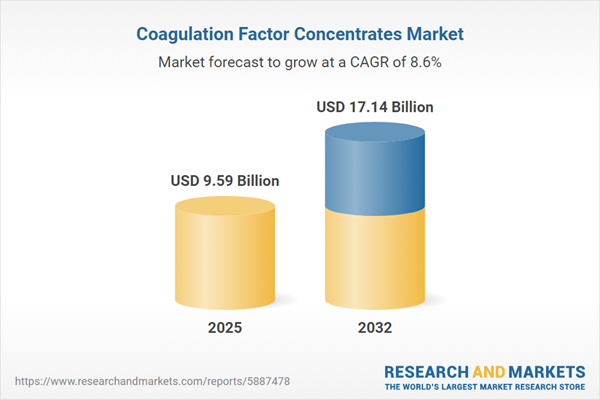Speak directly to the analyst to clarify any post sales queries you may have.
Senior decision-makers operating in the coagulation factor concentrates market face a dynamic landscape, driven by rapid clinical advancements, evolving regulatory frameworks, and increasing expectations for individualized patient care. Gaining strategic clarity in this sector depends on precise, up-to-date market intelligence.
Market Snapshot: Growth and Outlook for the Coagulation Factor Concentrates Market
The coagulation factor concentrates market exhibits sustained global expansion, reflected in steady revenue growth and a robust compound annual growth rate. Increased adoption of both plasma-derived and recombinant therapeutic options signals strong commitment to innovation across the bleeding disorders spectrum. Ongoing integration of advanced clinical protocols and broadening product portfolios contribute to resilience in established healthcare systems. Strategic agility is pivotal for market participants as volumes shift across regions and patient needs diversify, necessitating ongoing alignment with stricter safety and compliance requirements. This responsiveness is foundational to securing competitive positioning in international settings.
Scope & Segmentation: Insights for Senior Leadership in the Coagulation Factor Concentrates Market
This research equips senior executives with a detailed segmentation analysis to inform strategic decision-making amid changing global market dynamics. The segmentation framework enhances resource allocation and strategic focus as disruptive technologies, clinical demands, and evolving distribution models shape the sector.
- Product Types: Plasma-derived and recombinant formulations, available as both standard and extended half-life options, offer adaptable treatment pathways tailored to varied clinical management strategies for bleeding disorders.
- Indications: Application across Hemophilia A, Hemophilia B, and Von Willebrand Disease meets the needs of inherited and acquired bleeding disorder populations, broadening the therapeutic landscape and supporting wider access to care.
- Formulations: Choices between liquid and lyophilized powder concentrates provide flexible logistics and enable product stability, especially in specialized treatment facilities where storage and reconstitution requirements differ.
- End Users: Hospitals and specialty centers represent primary adopters, upholding high standards for the management of complex bleeding conditions and driving continual enhancement of patient care delivery.
- Distribution Channels: Key distribution pathways include hospital pharmacies, retail providers, and digital healthcare platforms, each optimizing therapy accessibility, logistics, and delivery models within healthcare ecosystems.
- Route of Administration: Intravenous administration enables precision dosing for flexible use across varied medical environments, ensuring continuity of care and safeguarding patient outcomes.
- Regions: The Americas, Europe, Middle East & Africa, and Asia-Pacific are each shaped by regionally specific regulatory processes, healthcare reimbursement mechanisms, and commercial strategies, influencing market opportunity and risk.
Influential market players such as CSL Limited, Grifols, Octapharma, Takeda, Pfizer, Novo Nordisk, Sanofi, Bayer, LFB, and Kedrion collectively drive competitive dynamics. For optimal market positioning, organizations must regularly track emerging research, investment trends, and region-specific developments.
Key Takeaways for Senior Decision-Makers
- Advancing product development and refining manufacturing contribute to enhanced regulatory alignment and improved supply chain security throughout the market.
- The shift toward extended half-life recombinant therapies is influencing care protocols, enabling personalizable treatment regimens and helping to increase therapy adherence.
- Digital health integration and real-world clinical data applications are streamlining decision-making, improving workflow, and supporting cohesive collaboration among providers and care teams.
- Collaboration between manufacturers, biotechnology companies, and academic research groups is vital for driving innovation, particularly in addressing rare and complex conditions.
- Optimization of global supply chains is a core focus as organizations adapt to evolving compliance mandates and more intricate international interdependencies.
Tariff Impact: Strategic Considerations for 2025
Recent tariff adjustments in the United States have added complexity for suppliers in the coagulation factor concentrates market. Senior executives are actively revisiting procurement methods, updating pricing strategies, and strengthening compliance frameworks to protect operational stability and reduce exposure to financial risk.
Methodology & Data Sources
The report draws on direct input from senior executive interviews, corroborated with secondary sources such as government agency data and peer-reviewed literature. Rigorous cross-checking and triangulation of data are conducted to uphold accuracy and generate strategic insights relevant to senior leadership.
Why This Report Matters
- Aligns strategy with the latest therapeutic and technological developments to support informed and agile decision-making in the coagulation factor concentrates sector.
- Enables effective navigation of diverse global regulatory requirements by supplying actionable and practical market intelligence for organizational adaptation.
- Delivers independently validated analysis, empowering leaders to reinforce long-term positioning and strengthen business continuity plans.
Conclusion
Timely, evidence-based insights allow senior leaders to proactively address shifts in the market and clinical landscape. Success in the coagulation factor concentrates space depends on adaptability and disciplined execution.
Additional Product Information:
- Purchase of this report includes 1 year online access with quarterly updates.
- This report can be updated on request. Please contact our Customer Experience team using the Ask a Question widget on our website.
Table of Contents
3. Executive Summary
4. Market Overview
7. Cumulative Impact of Artificial Intelligence 2025
Companies Mentioned
The companies profiled in this Coagulation Factor Concentrates market report include:- CSL Limited
- Grifols, S.A.
- Octapharma AG
- Takeda Pharmaceutical Company Limited
- Pfizer Inc.
- Novo Nordisk A/S
- Sanofi S.A.
- Bayer Aktiengesellschaft
- LFB S.A.
- Kedrion S.p.A.
Table Information
| Report Attribute | Details |
|---|---|
| No. of Pages | 191 |
| Published | November 2025 |
| Forecast Period | 2025 - 2032 |
| Estimated Market Value ( USD | $ 9.59 Billion |
| Forecasted Market Value ( USD | $ 17.14 Billion |
| Compound Annual Growth Rate | 8.6% |
| Regions Covered | Global |
| No. of Companies Mentioned | 11 |









